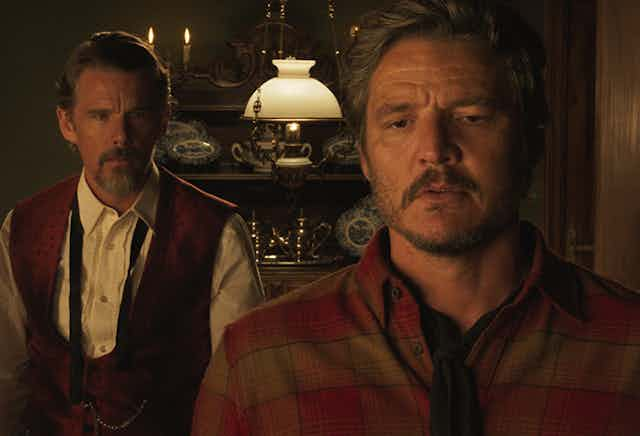Warning: this article contains spoilers for Strange Way of Life.
Every genre film is engaged – as self-aware genre pastiches like the Scary Movie (2000) and Scream (1996) franchises cannily acknowledge – in a conversation with its predecessors. The western, the longest-lived of all major genres, has been commenting on and reworking its own traditions since the silent era. Director and screenwriter Pedro Almodóvar’s new self-styled “queer western”, Strange Way of Life, is no exception.
Across its brief 30-minute runtime, Almodóvar reworks classical genre motifs – a stranger riding into town, ageing fellow outlaws now on opposite sides of the law, a desert pursuit and a Mexican standoff. But he does this in the novel context (for the western) of a love story between former gunslingers. Jake (Ethan Hawke) is now installed as sheriff of a small desert town, and Silva (Pedro Pascal) is his sometime fellow outlaw, friend – and lover.
Even after the breakthrough of Ang Lee’s Brokeback Mountain (2005) – a project Almodóvar turned down, to his subsequent regret – gay characters in westerns remain rare. Sixties underground or off-Hollywood films like Andy Warhol’s parody Lonesome Cowboys (1966) and the psychedelic Zachariah (1971) fleetingly brought a queer west onscreen. But from the 1980s onwards, as the western itself became a heritage genre in the hands of conservative custodians such as Clint Eastwood and Kevin Costner, the celluloid closet door was firmly slammed shut again.
Almodóvar and Peckinpah
Even so – and notwithstanding Almodóvar’s status as contemporary world cinema’s most prominent gay filmmaker – depictions of gay sexuality aren’t the most notably revisionist aspects of Strange Way of Life.
A flashback to the start of Jake and Silva’s romance shows the young bucks embracing one another in feverish, delighted passion. They quickly ignore their female companions, three Mexican prostitutes. The women show no outrage, judgment or even surprise at the men’s unabashed display – just a resigned recognition that they’ve lost this gig. The film depicts male same-sex desire as a difficult, but far from unimaginable, aspect of western life.
In any event, the Jake and Silva of Strange Way of Life’s principal action are not these young (and beautiful) hotshots, but two grizzled, lonely men in late middle-age, contemplating the missteps of their past and the shrinking path ahead.
This helps explain why the surprising key point of reference for Almodóvar’s muted, tender miniature is the notoriously macho director and screenwriter, Sam Peckinpah (1925-1984) – specifically, his epic and thunderously violent masterpiece, The Wild Bunch (1969).
No other major director more consistently or deeply explored the trope of the ageing gunslinger, whose impending obsolescence symbolises the closing of the frontier itself. Strange Way of Life’s allusions to The Wild Bunch are specific and distinctive – and have nothing to do with Peckinpah’s rhapsodic, slow motion bloodbaths.
That lovers’ flashback in Strange Way of Life is shared across the miles separating the two men from beside their separate campfires, as Jake tracks Silva across the desert. This scene follows a near-identical pattern to a sequence in Wild Bunch involving Pike Bishop (William Holden) and his friend and partner-turned-pursuer Deke Thornton (Robert Ryan). Almodóvar’s flashback also explicitly reworks another Wild Bunch scene, where two gang members indulge in a Bacchanalian near-orgy with Mexican prostitutes.
Peckinpah stays true to heteronormative genre conventions, using the (nameless) female sex workers simultaneously to arouse and repress homoerotic desire. But in Almodovar’s version, that desire is expressed jubilantly and carnally.
More importantly, while The Wild Bunch’s flashback revealed how Pike’s failings led to his friend heading up the posse that tracks the bunch relentlessly through that film, in Strange Way of Life, the shared fireside reverie between the estranged friends and lovers focuses instead on a precious, passionate memory that not only rebukes but may yet redeem their present situation.
Mid-life intimacy in Strange Way of Life
Arguably the most distinctive aspect of Almodóvar’s film, beyond its acknowledgment of same-sex desire, is its focus on mid-life intimacy.

Strange Way of Life unfolds mostly in domestic interiors – Jake’s quarters and Silva’s bedroom. Both rooms are meticulously furnished, to the point of fussiness (the film is part-funded by Yves St Laurent, with an executive producer credit for YSL lead designer Anthony Vaccaro).
These are very evidently lived-in private spaces – filled with mementos, tableware, carefully pressed linens and other tokens of their owners’ personalities. This marks a striking departure from the western’s typically spartan male spaces: rooming houses, gaols, mining camps.
The decisive action of The Wild Bunch takes place in one of those lifeless anti-domestic spaces, the cheerless hovel of a young Mexican prostitute where Pike finally acknowledges the hollowness of the values by which he has lived his life – a recognition that for him has only one outcome: wilful, bloody death.
In the aftermath of his own film’s only violent episode (complete with slow-motion gunplay), Almodóvar supplies a kind of gentle corrective to the patterns of intense male bonding and unspoken – or unspeakable — yearning that, in The Wild Bunch and so many other westerns, can perversely find expression only through lethal violence.
Having shot Jake to enable his no-good son’s escape, Silva tends his wound. At his bedside, he offers him a vision of a shared future beyond social – and genre – conventions. The film’s final line affirms the possibility of lives ending not in gunfire but in (queer) love, companionship and care.

Looking for something good? Cut through the noise with a carefully curated selection of the latest releases, live events and exhibitions, straight to your inbox every fortnight, on Fridays. Sign up here.

